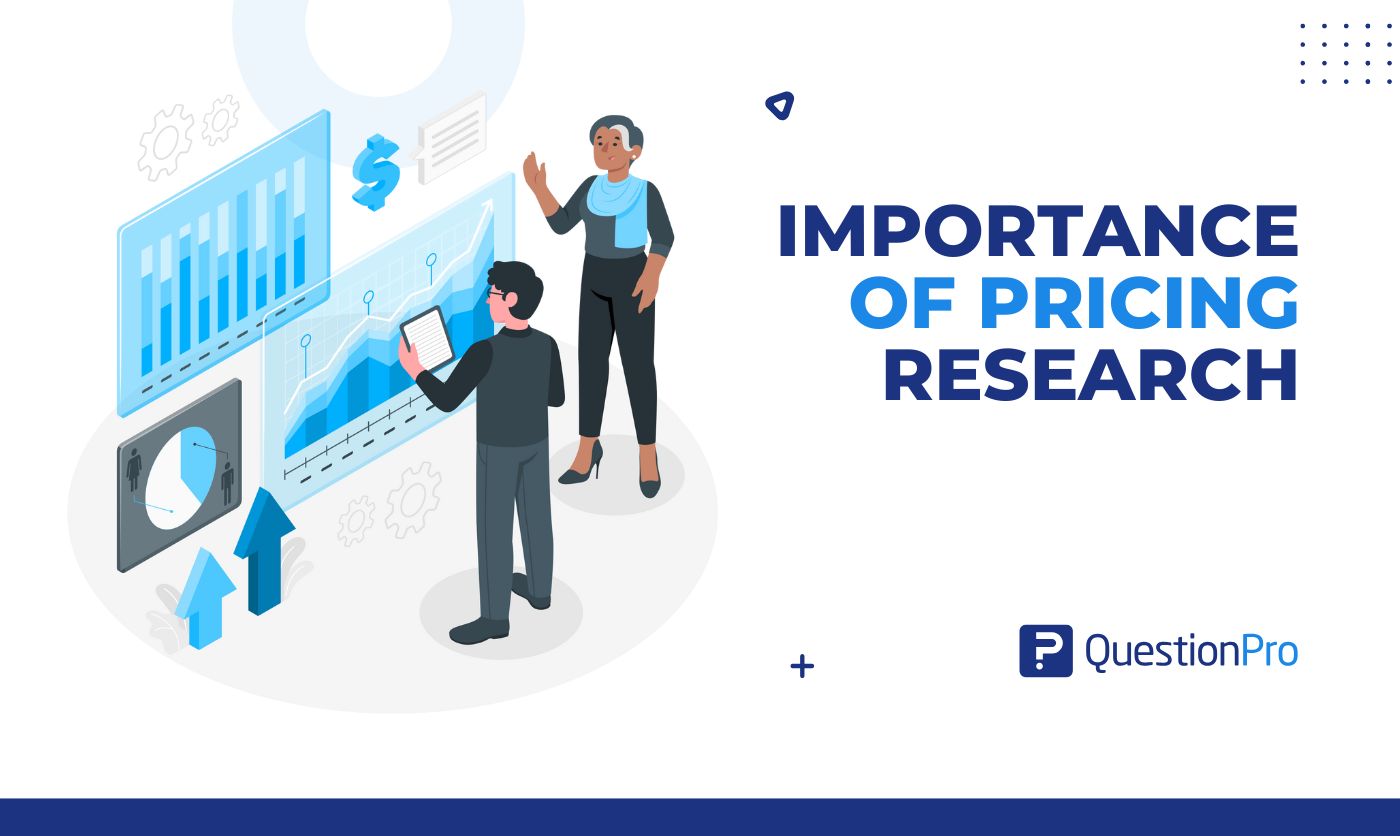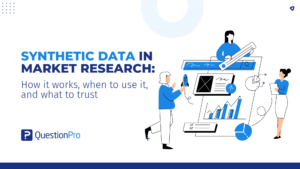
Pricing seems simple. You pick a number, put it on your product, and sell it. But in reality, pricing is one of the most important and complex decisions any business makes. That’s why understanding the importance of pricing research is so crucial.
If you get it wrong, the consequences will show up fast. For example, if you set your prices too high? Customers walk away. Customers walk away. Go too low? You’re leaving revenue behind and risking the long-term value of your brand.
Pricing is about understanding your market, recognizing customer perception, and identifying the optimal balance where value and profit meet. Without real data guiding your pricing decisions, you’re essentially making a guess, and in business, guessing is expensive.
In this blog, we’ll explore why pricing research matters, how it helps you make smarter decisions, and how you can use it to grow your business with confidence.
What Is Pricing Research?
Pricing research is the process of collecting real data from your customers and market to determine optimal pricing for your product or service. It helps you answer the questions that matter most:
- How much are customers actually willing to pay?
- How do they perceive the value of your product compared to alternatives?
- How sensitive are they to price changes?
- What happens to demand when you adjust the price up or down?
This isn’t just about looking at competitors’ prices or guessing what “feels fair.” It’s about understanding your audience and finding the pricing strategy that makes sense for them and for your bottom line. Value-based pricing sets prices based on the perceived value to the customer rather than on production costs. Pricing research is about building a pricing strategy that works in the real world, not just on paper.
What is the Importance of Pricing Research?
The wrong price can sink a great product. The right price can turn a good product into a market leader.
That’s why pricing research is essential, not optional. Whether you’re launching something new, adjusting an existing price, or testing a new model, research can help you make smarter, safer decisions.
Businesses that invest in pricing research can fine-tune their strategies and avoid costly mistakes. Here are the importance of pricing research:
1. It Turns Guesswork Into Data-Driven Pricing Decisions
Pricing is often based on assumptions:
- “Our competitor charges this much, so we should too.”
- “Customers won’t pay more than $50 for this.”
- “Let’s try $99 and see what happens.”
But assumptions are risky and usually expensive. Pricing research replaces guesswork with real insights. It tells you:
- What customers are truly willing to pay
- How much value they see in your product or service
- Where your competitors stand in the customer’s mind
For example, SaaS companies regularly run pricing studies to understand how new product features change perceived value. This lets them adjust pricing with confidence, not fear.
2. It Helps You Capture More Value Without Losing Customers
The cheapest price isn’t always the best price.
If you set your prices too low, you’re leaving money on the table. If you set them too high, you lose volume. Pricing research finds the sweet spot where customer satisfaction and profit align.
Take Starbucks, for example. Their coffee isn’t the cheapest, but research shows that customers are willing to pay extra for an exceptional experience, convenience, and brand loyalty. That’s strategic pricing backed by research, not random markup.
3. It Reveals What Features Are Worth Paying For
Not every feature drives value equally.
With pricing research, you can discover which features justify higher prices. For example, if you’re selling software, research might reveal that customers will pay more for:
- Advanced security features
- Faster customer support
- Customization options
Tiered pricing involves offering products at different price points with graduated features. On the other hand, things you thought were “must-haves” might turn out to be low-priority for your users. This helps you invest in the right upgrades and avoid unnecessary costs.
4. It Builds a Competitive Edge That is Hard to Copy
Competitors can copy your products, match your marketing, or undercut your prices. But they can’t copy your pricing strategy if it is based on customer research. Competitor-based pricing benchmarks your prices against competitors, adapting to market standards.
For example, Netflix frequently tests different pricing tiers across regions. By running these experiments, they learn exactly how customers respond before making global decisions. This proactive approach keeps them ahead of both competitors and customer expectations.
When you understand pricing better than anyone else in your market, you can lead the market.
5. It Protects Your Business from Pricing Mistakes
History is full of pricing missteps that could have been avoided with research:
- JCPenney removed discounts and switched to “everyday low pricing” without testing customer reactions. Sales dropped dramatically, and they had to reverse the decision, costing the company over $1 billion.
- Uber has tested surge pricing limits to avoid frustrating riders while maintaining driver availability. They use real-time pricing data to balance demand and supply without hurting loyalty.
Pricing research helps you avoid these mistakes by showing how different price points affect demand, loyalty, and perception before you make changes.
At the end of the day, pricing is about making smart decisions that drive profit, growth, and customer loyalty, not about making sales. Pricing research gives you the insights to do exactly that.
How Pricing Research Works
So, how do you actually figure out the best price for your product or service?
The answer is measure it, don’t guess it.
Pricing research uses real customer feedback to identify:
- Acceptable price ranges
- The “sweet spot” where price, value, and demand meet
- How pricing impacts sales, profit, and market size
Your goal is to find a price that’s profitable and competitive. Avoid setting the price too high or too low; instead, set it just right for your customers and your market. Quantitative pricing research focuses on numerical data to derive optimal pricing for products or services.
Let’s look at some of the most popular pricing research methods used by brands today:
1. Van Westendorp Price Sensitivity Meter: Find the Acceptable Price Range
The Van Westendorp Price Sensitivity Meter is a simple and powerful method that asks customers four specific questions:
- At what price would this product feel too expensive?
- At what price would it feel like a bargain?
- At what price would it feel too cheap to trust?
- At what price would it feel expensive but still worth it?
By collecting these responses, you get a clear range of acceptable prices, plus the optimal price point that maximizes both sales and customer comfort.
2. Gabor-Granger: Test Maximum Willingness to Pay
The Gabor-Granger method is straightforward and asks customers directly how likely they are to buy at different price points.

For example:
- Would you buy this product for $30?
- What about $40?
- At $50, would you still consider it?
By comparing answers, you’ll discover the highest price people are willing to pay before demand starts to drop off. It’s a quick and easy way to see how responsive your market is to price changes, which can help you understand price elasticity better.
3. Conjoint Analysis: Understand Feature vs. Price Trade-Offs
Conjoint analysis simulates real-world buying decisions by asking customers to choose between different product options. Each option has varying:
- Features
- Price points
- Service levels
Conjoint analysis is considered one of the most reliable methods for determining pricing. This helps you learn: This helps you learn:
- What features people are willing to pay more for
- Which combinations of price and features drive the most demand
- How your product compares to competitors in the eyes of the customer
For example, a smartphone company can test different bundles like:
| Package | Features | Price |
| Basic | 64GB, standard camera | $499 |
| Mid | 128GB, enhanced camera | $699 |
| Premium | 256GB, pro camera, extra warranty | $999 |
Conjoint analysis can tell you which package customers actually want and at what price they are willing to buy it.
4. Monadic (A/B) Price Testing: Try It and Measure the Reaction
Sometimes, the easiest way to test pricing is simply to test it. Monadic price testing involves showing different groups of customers different price points and asking if they would purchase at that price.
For example:
- Group A sees the product at $29
- Group B sees it at $39
- Group C sees it at $49
By comparing responses, you’ll see how demand changes with each price, which can help you set a price that maximizes both conversion and profit.
This is often done through survey-based testing rather than live experiments, so you can get insights before going to market.
QuestionPro’s Pricing Research Software makes these methods accessible, so you can run research without needing a data science team.
Risks of Ignoring Pricing Research
Skipping pricing research can backfire fast. Here’s what can happen:
- Underpricing = Lost Revenue
You sell more but make less profit because you’re charging below what customers are willing to pay.
- Overpricing = Lost Market Share
Customers walk away, choosing competitors who offer better value for the price.
- Random Price Changes = Confused Customers
Inconsistent pricing damages trust, making customers hesitant to buy or wait for discounts.
- Missed Premium Opportunities
Without research, you might undercharge for a product that could have positioned your brand at a higher-value tier.
How QuestionPro Can Help You Run Smarter Pricing Research
QuestionPro survey software includes built-in pricing research tools that help you test, measure, and adjust your pricing strategies with confidence, before you launch or make costly changes.
Here’s how QuestionPro makes pricing research accessible for everyone:
Collect Real Customer Feedback on Pricing
Before setting your prices, you need to know what your customers actually think. With QuestionPro, you can run:
- Price Rating Scales: Ask customers directly, “On a scale of 1–10, how fair do you think this price is for this product?” This gives you a quick overview of customer perception.
- A/B Price Testing: Conduct surveys that show different groups different price points and measure their intent to buy.
- Willingness-to-Pay Surveys: Ask customers directly how much they are willing to spend on your product or service. It’s a fast way to identify maximum price tolerance.
Run Pricing Experiments Before Launching
Launching with the wrong price is a risky move. With QuestionPro, you can test pricing in advance to avoid surprises. Our platform supports:
- Van Westendorp Price Sensitivity Meter
You can easily set up questions to discover the acceptable price range and ideal price point for your customers.
- Gabor-Granger Pricing Model
You can test multiple price points in one survey to find the tipping point where demand starts to drop.
- Conjoint Analysis
You can create feature vs. price trade-offs to understand how customers value your product’s different options.
How to Turn Pricing Survey Data into Profitable Business Decisions
Once you collect responses, QuestionPro helps you analyze the results in real time. You do not need spreadsheets or manual number crunching.
You’ll get:
- Visual dashboards to compare price points
- Demand curves and revenue projections
- Segmentation tools to see how different customer groups react to pricing
This means you can gather data and get clear, actionable insights to build pricing strategies that actually work.
Make Pricing Research Part of Your Strategy
Pricing research helps guide you in effectively communicating price changes, framing the value of your product or service so that customers understand and appreciate it. This results in higher conversions, stronger customer loyalty, and lower churn rates.
If your goal is to grow your business, knowing the importance of pricing research is essential. It protects you from costly mistakes and ensures your pricing strategy matches both market trends and customer expectations.
QuestionPro Pricing Research Software makes it easy to conduct pricing research, gather customer feedback, and analyze real data to find the optimal price range. It gives you the tools to do it all.
Ready to make smarter pricing decisions? Start using QuestionPro Pricing Research Software today and turn the pricing research into a competitive advantage.
Frequently Asked Questions (FAQs)
Answer: Pricing research helps businesses identify the optimal price point for their products or services. It ensures that pricing decisions are based on real customer data rather than assumptions, maximizing both profitability and customer satisfaction.
Answer: Pricing research is important because the wrong price can hurt sales, reduce profits, and damage brand perception. With proper research, businesses can avoid costly mistakes, capture more value, and stay competitive in the market.
Answer: If you skip pricing research, you risk underpricing (losing revenue), overpricing (losing market share), confusing customers with inconsistent pricing, and missing premium opportunities that could position your brand higher.
Answer: By identifying what customers are truly willing to pay and which features they value most, pricing research allows businesses to set a price that maximizes both profit and customer satisfaction without losing demand.
Answer: When pricing reflects customer-perceived value, customers feel the price is fair. This increases trust, satisfaction, and loyalty—reducing churn and strengthening long-term relationships.
Answer: QuestionPro offers built-in tools for Van Westendorp, Gabor-Granger, Conjoint Analysis, and A/B testing. It collects customer feedback, analyzes data in real-time, and provides demand curves and dashboards—making it easy to run pricing research without advanced technical skills.







